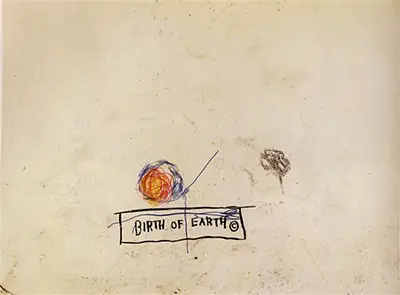The first thing to strike you about this painting is the written text of "Birth of Earth". This immediately gives us a clue as to what the rest of the content is related too but such was Basquiat's abstract and expressive style, we still are not entirely sure as to what the other items in the composition refer to. Most have classified this artist as part of the Neo-Expressionist movement but he was entirely unique in truth, and made use of different styles fused together to create a very original body of work. This particular artwork was made using a combination of acrylic, charcoal, crayon, pastel and pencil, with this artist regularly mixing different mediums together in the same piece. He liked to use thick paint alongside precise illustrations which would be hard to achieve with a single technique.
This was a fairly small artwork, but most of Basquiat's were actually produced on large canvases which could almost be described as murals. They would dominate over you and provide an extraordinary experience where as this artwork is smaller and draws you into the content, making you curious about what the artist is putting into the work, and any potential messages that he has placed within it. A study of his other pieces from that year could potentially give more clues as to the precise meanings found here.
This item can be found within the Daros Collection in Zürich, Switzerland and features alongside a number of Basquiat paintings, some of which are also featured within this website. The Daros Collection itself focuses almost entirely on modern art, covering some of the finest 20th century artists and so it is entirely unsurprising to find Basquiat featured here too. Other names to be found here include Mark Rothko, Barnett Newman, Willem de Kooning and Cy Twombly. It is run by the Stephan Schmidheiny family who continue to acquire new items for it fairly regularly and it is now a truly impressive selection of art for those interested in this particular period of art history.


